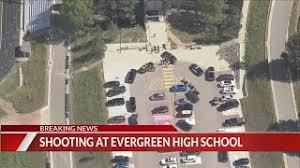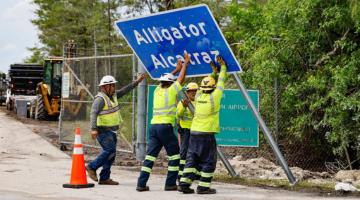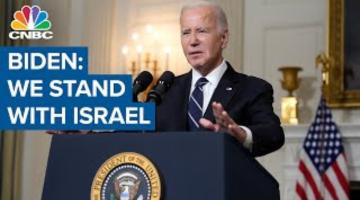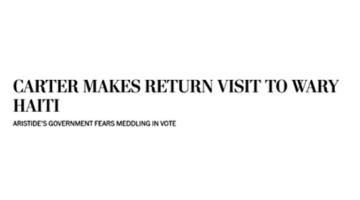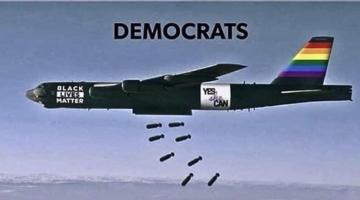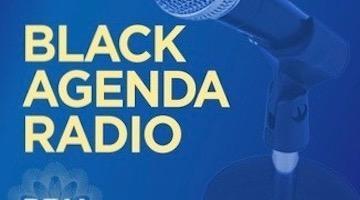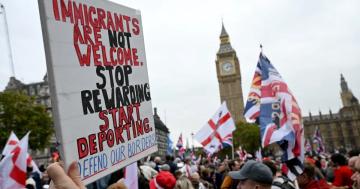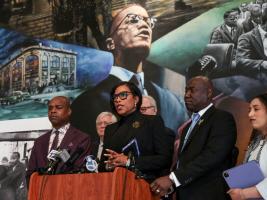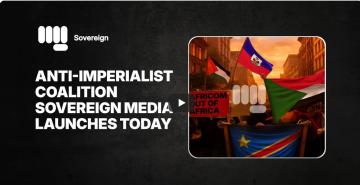"Protection" is a lie—a pretext for state violence, militarism, and control, targeting the marginalized while masking harm as care. True safety comes not from oppressive systems, but from resistance and collective liberation.
The language of “protection” saturates political rhetoric, from policing and incarceration to war and surveillance. But what and who is being protected? For communities long targeted by State violence, it is clear that protection propaganda often cloaks the machinery of harm. When State institutions claim to protect, they often mean to exploit, punish, and control. A people-centered human rights framework demands that we expose this deception.
Protection is the pretext, the marketing strategy, the moral cover. Within the U.S. and internationally, politicians deploy protectionist language to justify violence, often against the very groups they claim to shield. The language of safety has long been a smokescreen for militarism and carceral expansion. Propaganda is nothing new, but today’s protection rhetoric is uniquely sinister in how it weaponizes care to excuse cruelty.
Take Trump’s recent executive orders to “militarize police and punish sanctuary cities and refugees.” Packaged as national security measures, these policies deepen the alignment between policing and militarism, and further criminalize Black, brown, and migrant communities. This is not protection, it’s the State’s carceral arm capitalizing on the relationship between economic insecurity and xenophobia.
Yet, protectionist propaganda works. Trump has made significant gains in majority-Black and Hispanic counties, signaling how compelling these narratives can be when communities are disillusioned, systematically abandoned, and distracted by the Black Misleadership Class.
The UN Security Council established the “Responsibility to Protect” (R2P) as a guiding principle in 2006. Framed as protection for civilians under governments incapable or unwilling to interrupt or prevent grave harm (genocide, ethnic cleaning, and crimes against humanity), R2P was invoked to legitimize NATO’s intervention in Libya in 2011. This imposition was used to enact regime change that aligned with the liberal imperialist agenda. In this way, R2P is as deceptive as U.S. law enforcement’s ubiquitous motto: “to protect and serve.” Both military and carceral arms of the State deploy protection propaganda, sewing confusion and complacency in the general public while generating discursive shields for their war crimes.
A hybrid of military and carceral forces, Immigration and Customs Enforcement (ICE) is yet another entity that carries out state violence in the name of security. One example is the guise of conducting “welfare checks,” ICE targets children – not only for detainment and deportation, but also as bait for their undocumented loved ones. While the recent raids and deportation efforts have not yet reached the numbers achieved under former U.S. President Barack Obama, they are nonetheless terrorizing migrant and mixed-status communities all over the country. When the people stand up and fight back – as protestors recently did in Los Angeles – they are met with domestic warfare: local law enforcement, followed by thousands of National Guard troops, followed by hundreds of Marines. While California Governor Gavin Newsome and President Donald Trump argue over state sovereignty and federal overreach, civilians in the U.S. remain under attack by armed forces, even those ostensibly aimed abroad. We are endangered, not protected by this effort to mix policing with the military.
The State’s protectionist propaganda often features this inversion of the predator and dispossessed. Focusing on the intersection of carcerality and militarism elucidates this perversion of protection. In “Black, Brown, and Invisible,” Rafia Zakaria makes it plain: “just as the imprisonment of every black man convicted is imagined just, all those killed by drones are terrorists.”
In the UK, policies like the Prevent policy are allegedly meant to stop “radicalization,” but target Muslim youth for surveillance under similar allegedly protective rationales. The Prevent policy was introduced in 2003 as part of the State’s counter-terrorism strategy, linking local policing with national security forces. As of 2015, all employees of public institutions are legally mandated to participate in the effort to “prevent terrorism.” Notably, critics argue that Prevent is rooted in Islamophobia and yet it was claimed that, “a partnership approach with Muslim communities has been at the heart of delivering these Prevent objectives.” Surveillance is not a form of protection, especially when it’s disguised as community outreach.
In Gaza, the myth of protection is used to justify genocide. Zionist ideology presents the ongoing genocide and displacement of Palestinians as necessary for Jewish people’s safety and for the security of the U.S.. Protecting their financial and political investments in the Zionist project, the U.S. ruling class funnels billions in military funds and weapons to “Israel” while dangling morsels of aid over Gaza. We must remember how Israel made a martyr of five-year-old Hind Rajab, and continues to kill a child every 45 minutes. The State’s expressions of concern for protecting children – or anyone besides the ruling class – are deception.
Meanwhile, Black and brown children in the U.S. are groomed for war under the pretense of protection from poverty. Project 2025 includes proposals to expand Junior Reserve Officers' Training Corps (JROTC) programs, increase military recruiter access to young people, and require all students in federally funded schools to take the military entrance exam. Already, over 500,000 students are enrolled in JROTC (often involuntarily), especially in schools that are under-resourced and majority Black or Brown. Who does this protect?
The same manipulation exists within carceral logics. We see Stop Cop City (also known as Defend the Atlanta Forest) activists fighting back against militarized policing and paying the price with their lives and freedom. It’s worth noting that this Cop City is “officially” known as “Atlanta Public Safety Training Center.” Consider some other insidious carceral examples such as solitary confinement, especially for Black youth; another carceral perversion of protection frameworks, as the inhumane practice is often justified as “protective” custody. Trans people in prisons often face even more extreme isolation with the excuse that it is for their safety. But these acts of purported protection are dehumanizing and dangerous. The state uses the language of protection to rationalize torture and abandonment.
Cash bail is another iteration of the protection lie buoying the punishment bureaucracy. Framed as a way to ensure public safety and prevent flight risk, bail actually functions as a poverty tax. It disproportionately traps Black, brown, and other working class people in jails for days, weeks, and even months without trial. There’s nothing protective about it; it is punitive by design.
Internationally, we now see the exportation of this logic through “prison imperialism” and specifically, the practice of outsourcing incarceration to countries like El Salvador. The current administration has proposed similar deals with Liberia and Rwanda too. These schemes reveal the underlying function of carceral and imperialist structures is to sustain the capitalist status quo and moreover, the war on African people globally.
Food (another basic right) is also subjected to protection propaganda. The Trump administration proposes deep cuts to Supplemental Nutrition Assistance Program (SNAP) while demanding detailed personal information from applicants. These moves target immigrants and feed mass surveillance, all while pretending to fight fraud (and thus, protect the taxpayers). Meanwhile, Israel starves Gaza in plain sight and those who distribute food in war zones are labeled threats. This is the age-old “divide and conquer” tactic masquerading as protection.
Recent refugee policies further expose the hypocrisy of protection provided by the State. Trump welcomes white South Africans into the U.S. to “protect” them from accountability for apartheid, while rejecting and caging Black and brown asylum seekers. This double standard only amounts to protection for global white supremacy.
As scholars have noted elsewhere, child protection is the “ultimate trump card.” (Mintz, 2016) Politicians invoke children to justify surveillance, war, and censorship. But if protecting children was the mission, one in six wouldn’t live in poverty in the U.S. We wouldn’t see millions impacted by parental incarceration. And we wouldn’t see the State surveilling, detaining, recruiting, and massacring kids under the guise of protection.
Children are a stark and urgent example, but this same logic applies to migrants, prisoners, trans people, people with disabilities, people facing housing insecurity — all of humanity. The language of protection both exacerbates irrational fears and offers a (superficial) sense of resolution. But we must not allow ourselves to be fooled. The enemy killing babies in Gaza is the same war machine building another Cop City to target Black and brown youth in Baltimore, and poisoning older Black residents in Florida.
Protectionist propaganda is the bridge between manufactured consent for carceral violence and militarized control. It’s time we stop asking to be protected by systems built to harm us.
Protection from State violence can be arranged through political will, community investment, and organization. We can start by recognizing and resisting false (com)promises of protection.
Aiyana Porter-Cash is a PhD candidate in Critical Social Psychology at CUNY Graduate Center. She is a member of Black Alliance for Peace and the Release Aging People in Prison campaign (RAPP).


